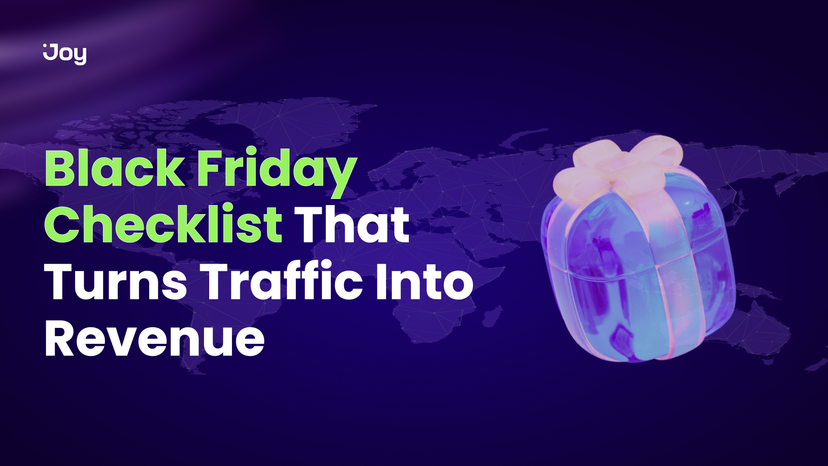Did you know that improving customer retention by just 5% can increase profits by 25% to 95%, according to Bain & Company? This surprising statistic shows just how important customer retention is. While many businesses focus on gaining new customers, keeping existing ones is where the real opportunity lies. Loyal customers tend to spend more and are also more likely to recommend your business to others, creating a chain reaction of growth.
In this guide, we’ll explain customer retention definition, why it’s critical for long-term success, and share practical strategies to help you improve retention and maximize profitability.
What is Customer Retention?
Customer retention is a key measure of how well a business builds and maintains long-term customer relationships. It shows loyalty, satisfaction, repeat purchases, and emotional connections.

A business with high customer retention rates enjoys consistent repeat purchases, loyal customers, and positive word-of-mouth referrals. As a result, the business benefits from a stable income and lower costs for acquiring new customers. High retention reflects strong customer satisfaction and effective customer experience (CX) strategies.
In contrast, businesses with low retention rates often experience high customer churn. Customers may make a single purchase and never return it, leave negative reviews, return products, or stop engaging with the brand altogether. This makes it hard for the business to build lasting relationships and results in fewer repeat sales.
So, by tracking retention rates, businesses can assess the effectiveness of their customer experience (CX) strategies and identify areas for improvement.
Why is Customer Retention Important?
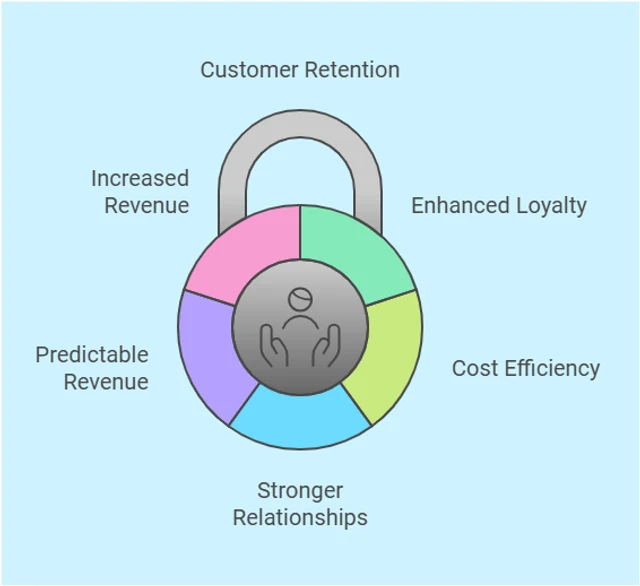
Customer retention is crucial for sustainable growth and long-term success, offering several key benefits:
- Cost Efficiency: Retaining existing customers is far cheaper than acquiring new ones. Research shows that gaining new customers can cost 5 to 25 times more than keeping loyal ones, as they already trust your brand and require less marketing spend.
- Increased Revenue: Loyal customers spend more over time. Compared to new customers, they are 50% more likely to try new products and 31% more likely to increase their spending. This makes upselling and cross-selling more effective, driving additional revenue growth.
- World-of-Mouth Referrals: When satisfied customers are more likely to recommend your product/service to others, bringing in new customers without additional cost. Nielsen reports that 92% of consumers trust recommendations they know.
- Higher Profit Margins: Loyal customers are often willing to pay a premium for products or services they trust. They also choose you when competitors offer lower prices, which can help maintain healthy profit margins.
- Better Insights and Feedback: Long-term customers provide valuable feedback to help businesses improve their products or services. They understand the brand well and can offer insights into what works and what doesn’t.
- Reduced Churn: By focusing on retention, businesses can minimize customer churn and maintain a solid base of loyal customers. Lower churn rates lead to more stable growth and long-term sustainability.
How to Measure and Optimize Retention Strategy Performance?

Measuring the performance of your customer retention strategy is essential to understand its effectiveness and identify areas for improvement.
Here’s a quick comparison table highlighting their definitions and formulas:
| Metric | Description | Formula/Example |
| Customer Retention Rate (CRR) | Percentage of customers retained over a period. | [(E – N) ÷ S] × 100 |
| Customer Churn Rate (CCR) | Rate of customers lost over time. | (Y ÷ X) × 100 |
| Customer Lifetime Value (CLV) | Total value a customer contributes during their lifecycle. | Avg. Purchase Value × Purchase Frequency × Avg. Customer Lifespan |
| Repeat Purchase Rate | Percentage of customers who buy more than once. | (Repeat Customers ÷ Total Customers) × 100 |
Customer Retention Rate (CRR)
This metric shows the percentage of existing customers who stayed with your businesses over the given period, offering a clear view of your business’s ability to maintain customer loyalty.
Why It Matters: A high retention rate indicates strong customer satisfaction and engagement. It helps you understand how well your products or services meet customer expectations.
Formula: CRR = [(E – N) ÷S] × 100
Noted:
- E is the total number of customers at the end of a period
- N is the number of new customers acquired during the period
- S is the number of customers at the start of the period
For example: If you start with 500 customers, acquire 50 new ones, and end with 520 customers, your retention rate is:
=> CRR = [(520 – 50) ÷ 500) × 100 = 94%
This result shows that 94% of your original 500 customers stayed loyal, while only 6% were lost. It suggests strong customer satisfaction and effective retention strategies. Most customers decided to keep doing business with you instead of leaving, which is a clear sign that your efforts are working well.
Customer Churn Rate (CCR)
The customer churn rate (the opposite of CRR) calculates the percentage of customers lost during a specific period.
Why It Matters: A high churn rate signals dissatisfaction or unmet expectations, urging businesses to take corrective action.
Formula: CCR = (Y÷ X) × 100
Noted:
- Y is the number of lost customers at the end of a period.
- X is the number of total customers at the start of the time period.
Example: If you had 500 customers at the start of a month and lost 40, your churn rate is:
=> CRR = (40 ÷ 500) × 100 = 8%
This number shows that 8 out of 100 customers chose to stop doing business with you. A churn rate of 8% means that although most customers stayed loyal, a notable percentage left, suggesting improvements in customer retention might be needed.
Customer Lifetime Value (CLV)
CLV shows how much profit a customer brings to your business over their entire relationship. If CLV is low, you can invest in loyalty programs to boost repeat business. On the other hand, if CLV is high, you can afford to spend more on acquiring new customers.
- Formula: CLV = Average Purchase Value × Purchase Frequency × Customer Lifespan
- Example: If a customer spends $100 per purchase, buys 5 times a year, and remains loyal for 3 years, their CLV is: CLV = 100 × 5 × 3 = 1500.
This number shows that the customer will contribute $1,500 in total profit throughout their 3-year relationship with your business.
Repeat Purchase Rate
This metric measures the percentage of customers who make multiple purchases, reflecting customer loyalty and satisfaction.
Formula: Repeat Purchase Rate = (Number of return customers ÷ Total number of customers) × 100
Example: If you have 300 customers, 120 of whom made more than one purchase, your repeat purchase rate is 40%.
=> Repeat Purchase Rate = (120 ÷ 300) × 100 = 40%.
How To Build a Customer Retention Strategy
Building a successful customer retention strategy involves creating a plan that keeps your customers engaged, satisfied, and loyal over time. Here’s a step-by-step guide to help you create an effective retention strategy:
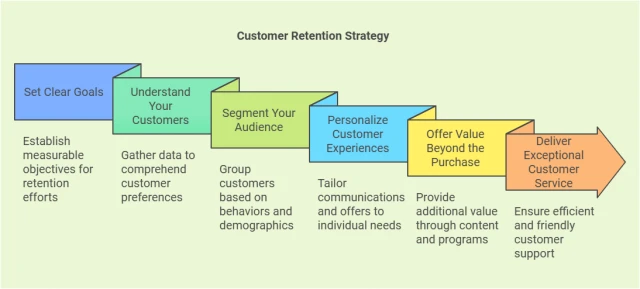
Step 1: Set Clear Goals
Begin by defining measurable and achievable objectives for your retention efforts. For example, aim to reduce customer churn by 10% within a year or increase repeat purchase rates by 15%. Clear goals provide a roadmap and make it easier to track progress.
Step 2: Understand Your Customers
Gather data and feedback to understand your customers’ preferences, pain points, and expectations. Tools like customer surveys, reviews, and analytics can uncover valuable insights to enhance their experience. The better you know your customers, the better you can serve them.
For example, Starbucks uses its mobile app to collect data on customer preferences, order history, and frequency of visits. The app also encourages customers to provide feedback through surveys and ratings. After a customer makes a purchase, Starbucks may prompt them to rate their experience, or the company sends out occasional surveys asking for input on new products.
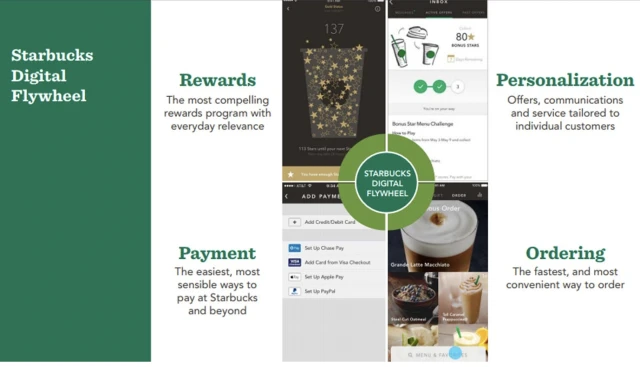
Step 3: Segment Your Audience
Not all customers are the same. Group them based on behaviors, demographics, or value (e.g., high-value vs. occasional buyers). Segmentation allows you to target your retention efforts effectively, delivering messages and offers that resonate with each group.
Step 4: Personalize Customer Experiences
Personalization is key to enhancing customer satisfaction and loyalty. By tailoring your communications and offers to individual customers based on their purchase history or preferences, you can create a more relevant and engaging experience. For instance, sending personalized recommendations, special promotions, or discounts based on previous purchases shows customers that you understand their needs.
Targeted messaging, such as email reminders for abandoned carts, birthday greetings, or exclusive offers, can also drive repeat purchases and strengthen customer relationships.
Step 5: Offer Value Beyond the Purchase
Retention isn’t just about the sale—it’s about long-term value. Provide educational content, loyalty programs, or exclusive access to resources. By continually adding value, you give customers reasons to stay engaged with your brand.
Zappos offers free returns within 365 days, allowing customers to return products at no cost. This gives customers peace of mind and encourages repeat purchases. For example, when a customer received shoes late for a special event, Zappos arranged same-day delivery of a new pair and upgraded their shipping for free. The customer was so impressed they shared the experience online, leading to free word-of-mouth marketing.

Zappos’ commitment to delivering exceptional customer service has helped the company build a loyal customer base. According to reports, Zappos’ customer retention rate is around 75%, and their reputation for outstanding service plays a significant role in keeping customers coming back.
Step 6: Deliver Exceptional Customer Service
Ensure your customer support is fast, friendly, and efficient across all touchpoints—whether through live chat, email, or phone. A seamless customer service experience can turn a frustrated customer into a loyal advocate.
Step 7: Implement a Feedback Loop
Regularly collect and act on customer feedback through surveys, reviews, and ratings. Understanding what’s working and what’s not will help you improve products, services, and overall customer satisfaction.
Step 8: Create Community and Engagement
Building a strong community around your brand is key to fostering customer loyalty. Create online spaces, such as social media groups or forums, where customers can connect with your brand. Respond to comments and questions, share customer success stories to inspire others, and host exclusive online events to strengthen relationships.
3 Successful Customer Retention Strategies
Netflix
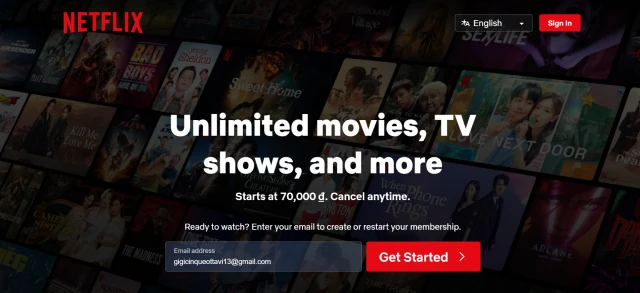
Netflix has become a leader in customer retention through its innovative approach to personalization, content delivery, and user experience. The streaming giant has implemented several strategies that have helped it keep customers returning month after month.
Retention Strategy & Data:
- Personalized Content Recommendations: Netflix’s algorithm tailors content based on viewing habits, ratings, and search history, keeping users engaged. In 2020, 80% of content discovery came from recommendations.
- Continuous Content Expansion: By investing in exclusive, original content, Netflix reduces churn and keeps users loyal with offerings they can’t find elsewhere.
- Seamless User Experience: The user-friendly interface and ad-free, consistent cross-platform experience enhance customer satisfaction and retention.
- Customer-Centric Approach: Netflix actively listens to feedback and improves features like the “Skip Intro” button to enhance user control and satisfaction.
Lessons Learned:
- Tailored recommendations based on user behavior increase engagement and retention.
- Investing in high-quality, exclusive content builds loyalty and adds value beyond the subscription.
- Prioritizing user experience makes customers feel valued, ensuring long-term retention.
- Actively responding to customers’ feedback helps improve the product and foster customer loyalty.
Amazon Prime

Amazon has established itself as a top player in customer retention by offering a unique combination of convenience, value, and loyalty benefits. With over 200 million members globally, Amazon Prime’s retention strategy is a great example of how a mix of services can keep customers hooked.
Retention Strategy & Data:
- Exclusive Benefits & Value: Amazon Prime offers perks like free shipping, exclusive discounts, and early sale access, increasing the membership’s value and discouraging cancellations.
- Convenience & Speed: Fast, free shipping—often same-day or two-day—makes it hard for customers to switch to other retailers due to its convenience.
- Personalized Recommendations: Amazon uses customer data to offer tailored product and video recommendations, improving the shopping and entertainment experience.
- Exclusive Content on Prime Video: Original shows like The Boys and The Marvelous Mrs. Maisel provide exclusive content, keeping customers engaged with more than just retail offerings.
Lessons Learned:
- Bundle services for value, such as (shipping, streaming, discounts) to boost perceived value.
- Personalization strategy for understanding preferences and providing tailored recommendations.
- Unique content or perks add value and make retaining customers easier.
Starbucks Rewards
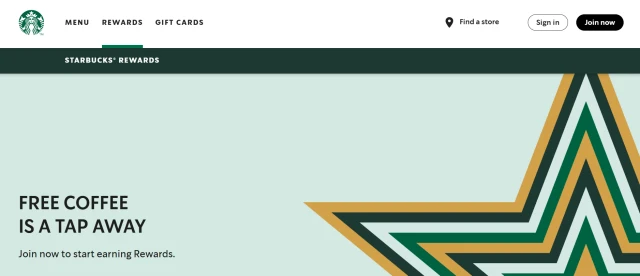
Starbucks has effectively integrated its Starbucks Rewards program into its customer retention strategy, making it one of the most successful loyalty programs. The company uses the program to foster customer loyalty by rewarding customers for frequent visits, personalized offers, and exclusive benefits.
Members earn stars for every purchase made through the app or a registered card, which can be redeemed for free drinks, food, and other rewards. The program also offers personalized rewards based on customer preferences and past purchases, enhancing the experience.
By using customer data, Starbucks sends tailored offers, such as birthday drinks or discounts on favorite items. As of 2023, the Rewards program has over 28 million members in the U.S., accounting for 50% of Starbucks’ total U.S. sales. Starbucks Rewards members spend 2.5 times more per year than non-members, and over 40% of U.S. revenue comes from Rewards customers. This program drives repeat visits and strengthens customer loyalty, fueling consistent revenue growth.
Retention Strategy & Data:
- Personalized Rewards: Customers earn stars for purchases, redeemable for free drinks or food, with rewards tailored based on purchase history.
- Mobile App & Digital Integration: The app tracks points, allows payment, and provides personalized offers, enhancing convenience and encouraging frequent visits.
- Exclusive Offers & Promotions: Members receive perks like double star days, birthday rewards, and early product access, boosting brand engagement.
- Tiered Membership: Green and Gold levels offer more rewards as customers spend more, increasing engagement through tier-based incentives.
- Emotional Connection & Community: Personalized experiences and a sense of belonging foster deeper customer loyalty.
Lesson Learned:
- Personalizing rewards and tailoring offers based on customer behavior increases engagement.
- Offer exclusive deals to keep customers engaged and coming back.
- Implement tiered programs to deepen customer loyalty.
- Personalized experiences and community engagement drive loyalty.
5 Tools for Improving Customer Retention
CRM Software: HubSpot, Salesforce

CRM software like HubSpot and Salesforce are some of the most powerful and widely used platforms globally. They are known for their extensive customization, advanced features, and integrations. These platforms offer a comprehensive suite of tools to help businesses manage customer relationships, improve customer retention, and boost sales through better insights and automation.
Key Features:
- Automation of follow-up emails, reminders, and personalized offers
- Track and manage leads, opportunities, and customer journeys through customized workflows.
- Automate sales processes, track engagement and manage pipelines for customer retention.
- Manage customer service requests, complaints, and support interactions to enhance retention.
- Use Salesforce’s Einstein AI to gain predictive insights and optimize retention strategies.
- Create automated and personalized communication through email, social media, and mobile apps.
- Access thousands of third-party apps to extend functionality and meet specific business needs.
Benefits:
- A 360-degree view of customer data, helping businesses provide a tailored, personalized experience that drives loyalty.
- Advanced automation & AI predictive analytics, customer behavior, and proactive retention strategies.
- Highly customizable to meet the needs of small businesses and large enterprises.
- Available in multiple languages and currencies, making it ideal for businesses with an international customer base.
Customer Feedback Platforms: SurveyMonkey, Qualtrics
Platforms like SurveyMonkey and Qualtrics allow companies to create custom surveys and collect real-time feedback on customer experience, from product satisfaction to service quality.
SurveyMonkey is known for its simplicity and ease of use, making it a popular choice for small to medium-sized businesses. It offers customizable survey templates, real-time reporting, and the ability to distribute surveys across multiple channels.
On the other hand, Qualtrics is a more advanced platform that provides in-depth analysis and experience management tools for large enterprises. With its AI-powered analytics, multi-channel feedback collection, and integration with business systems, Qualtrics allows businesses to track customer sentiment across the entire journey, offering deeper insights for strategic decision-making.
Key Features
- Net Promoter Score (NPS) tracking to measure customer loyalty
- Advanced survey customization and logic (e.g., skip logic, randomization, branching)
- AI-powered analytics for text analysis and predictive insights
- Multichannel feedback collection (email, SMS, mobile app, website, in-person)
- Integration with third-party tools (e.g., CRM, email marketing software)
- Real-time reporting and customizable dashboards
- Basic data export to CSV, PDF, or Excel for further analysis
- Experience Management (XM) for managing customer, employee, product, and brand experiences
Benefits
- Intuitive user interface without technical knowledge
- Gathering and analyzing feedback quickly to make adjustments to customer experiences
- AI-powered tools and advanced analytics to drive strategic improvements
- Flexibility to tailor surveys to specific customer segments, providing more actionable insights
Marketing Automation Tools: Mailchimp, ActiveCampaign
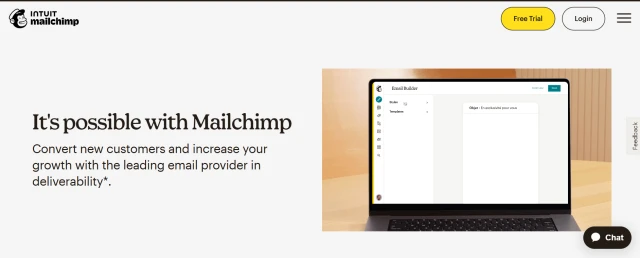
Marketing automation platforms like Mailchimp and ActiveCampaign play a crucial role in customer retention by streamlining communication, personalizing customer interactions, and nurturing relationships over time. Both tools offer powerful features for businesses to automate and optimize their email marketing campaigns, improving engagement and customer loyalty.
Key Features:
- Easy-to-use drag-and-drop email builder
- Behavioral automation and triggered emails (e.g., welcome emails, abandoned cart reminders)
- Customer segmentation based on demographics, behavior, and purchase history
- Integration with multiple third-party tools and platforms (e.g., Shopify, WordPress)
- A/B testing for optimizing email performance
- Reporting and analytics for campaign tracking and improvement
- Built-in CRM for managing customer relationships and tracking interactions
- Dynamic content personalization based on customer behavior and preferences
- Conditional logic for highly targeted, customized communication
Benefits
- Increases engagement with behavior-driven, multi-channel automation (email, SMS, and more)
- Strengthens customer loyalty through seamless, automated workflows
- Improves customer retention by delivering timely, relevant content based on customer behavior and lifecycle stage
- Helps increase customer lifetime value by efficiently managing and tracking customer interactions across various touchpoints
- Simplifies the creation and execution of personalized, behavior-triggered email campaigns
- Enhances customer engagement with targeted messages, improving the likelihood of repeat purchases
- Offers robust automation workflows to nurture customer relationships over time
Loyalty Program Software: Joy Loyalty, Smile.io

Joy Loyalty and Smile.io are leading loyalty program platforms that enable businesses to build and manage reward programs that drive customer retention and boost engagement. Both platforms offer easy-to-use solutions for creating personalized, effective loyalty programs that encourage repeat purchases, increase customer lifetime value (CLV), and foster emotional connections with customers.
Key Features
- Customizable loyalty programs with points-based, tiered, and referral systems.
- Referral programs for additional rewards.
- Multi-channel integration with eCommerce platforms (Shopify, WooCommerce) and mobile apps.
- Engagement tools include email marketing and automated notifications
- Track customer behavior, program performance, and engagement metrics.
- Create exclusive, high-value benefits for loyal customers.
- Gamification features include progress bars, badges, and milestones to engage customers.
Benefits
- Builds emotional connections with customers through personalized rewards.
- Increases customer lifetime value (CLV) and repeat purchases.
- Taps into social networks to drive new customer acquisition.
- Boosts repeat purchases and customer engagement.
- Encourages word-of-mouth marketing through referrals.
- Flexible and scalable for businesses of all sizes.
Customer Analytics Tools: Google Analytics, Amplitude
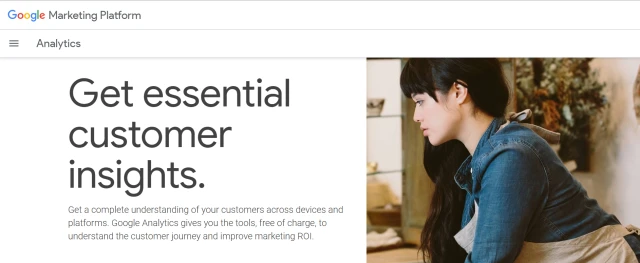
Google Analytics and Amplitude are powerful tools for tracking and analyzing customer behavior. They provide valuable insights into customer journeys, helping identify trends, pain points, and optimization opportunities. By understanding customer interactions, businesses can make data-driven decisions to improve experiences, boost loyalty, and enhance long-term retention.
Key Features
- Provides up-to-the-minute insights into user behavior and interactions
- Groups customers based on shared characteristics or behaviors to track retention trends over time
- Uses data to forecast potential churn, enabling proactive retention actions
Benefits
- Identifies opportunities for improving the customer experience and retention
- Tracks the effectiveness of retention strategies, allowing businesses to fine-tune their approach
- Helps companies to make data-driven decisions to increase long-term customer loyalty and satisfaction
5 Common Retention Tactics to Boost Strategy Success
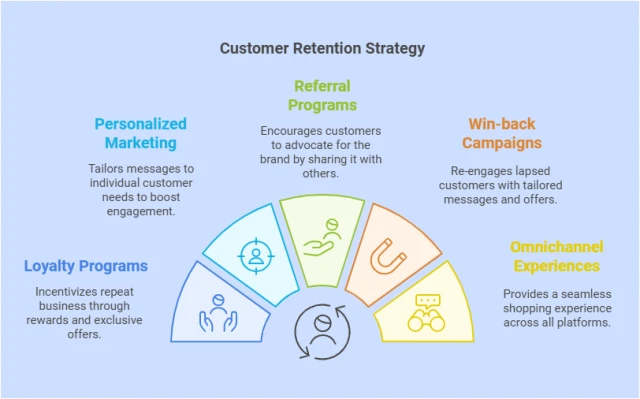
To enhance your customer retention efforts, consider implementing the following proven tactics. These strategies help build stronger relationships with your existing customers and foster long-term loyalty and advocacy.
- Implement Loyalty Programs. Loyalty programs incentivize continued purchases with rewards, discounts, or exclusive perks, boosting satisfaction and repeat business. Platforms like Joy Loyalty create seamless and effective loyalty systems that increase retention.
- Create Personalized Marketing Campaigns: Tailor marketing messages to individual customer needs by analyzing their data, boosting engagement and retention. Use insights to craft offers and content that resonate with your customers, making them feel valued.
- Introduce Referral Programs: Referral programs reward customers for sharing your brand with others, turning satisfied clients into advocates.
- Regularly Re-engage Lapsed Customers with Win-back Campaigns: Win-back campaigns help reignite interest by offering tailored messages, exclusive deals, or simple check-ins.
- Provide Seamless Omnichannel Experiences: Offer a smooth omnichannel experience across digital, in-store, and mobile platforms, ensuring customers can engage anywhere, anytime.
Challenges in Retaining Customers and How to Overcome Them
Retaining customers is a constant challenge for many businesses, but identifying potential obstacles and addressing them proactively can significantly improve retention rates. Here are some common hurdles and strategies to overcome them.
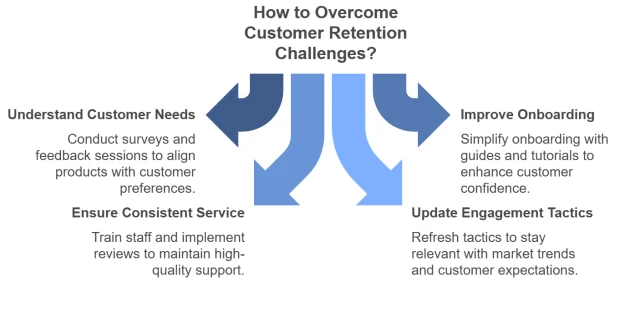
1. Lack of Understanding of Customer Needs
- Problem: Without knowing what customers truly want, delivering meaningful experiences is difficult.
- Solution: Use surveys, interviews, and feedback to gain insights into customers’ preferences and needs and align your offerings accordingly.
2. Poor Onboarding Processes
- Problem: Complicated onboarding can lead to early disengagement.
- Solution: Simplify the process with step-by-step guides, tutorials, or walkthroughs to make customers feel confident.
3. Inconsistent Customer Service
- Problem: Inconsistent service erodes trust and satisfaction.
- Solution: Train your team for consistency and regularly review performance to ensure quality service at every touchpoint.
4. Irrelevant or Outdated Engagement Tactics
- Problem: Old engagement tactics may no longer resonate with customers.
- Solution: Keep up with trends and refresh your strategies to remain relevant and appealing to current customer expectations.
Bottom Line
Customer retention isn’t just a buzzword—it’s the cornerstone of long-term business success. The key is to stay proactive, be adaptable, and always listen to your customers. With the right tools, tactics, and mindset, you can transform one-time buyers into loyal advocates, ensuring your business thrives for years.
Customer Retention Definition: FAQs
What is meant by customer retention?
Customer retention refers to a company’s ability to keep its customers over time. It measures customer loyalty by tracking how many customers continue to do business with the company and is often reflected in metrics like repeat purchases or customer lifetime value.
What is an example of customer retention?
An example of customer retention is when a customer subscribes to a service for a long-term period, like a monthly gym membership or a Netflix subscription, and continues renewing their subscription due to satisfaction with the service and experience.
What is good customer retention?
Good customer retention is when a business can consistently retain a high percentage of its customers over time. Typically, a retention rate of 85% or higher is considered excellent, although this varies depending on the industry.
What is a customer retention role?
A customer retention role focuses on strategies and initiatives to keep customers loyal to a business. This role may involve analyzing customer behavior, implementing loyalty programs, managing customer service efforts, and creating personalized experiences to ensure satisfaction and long-term engagement.
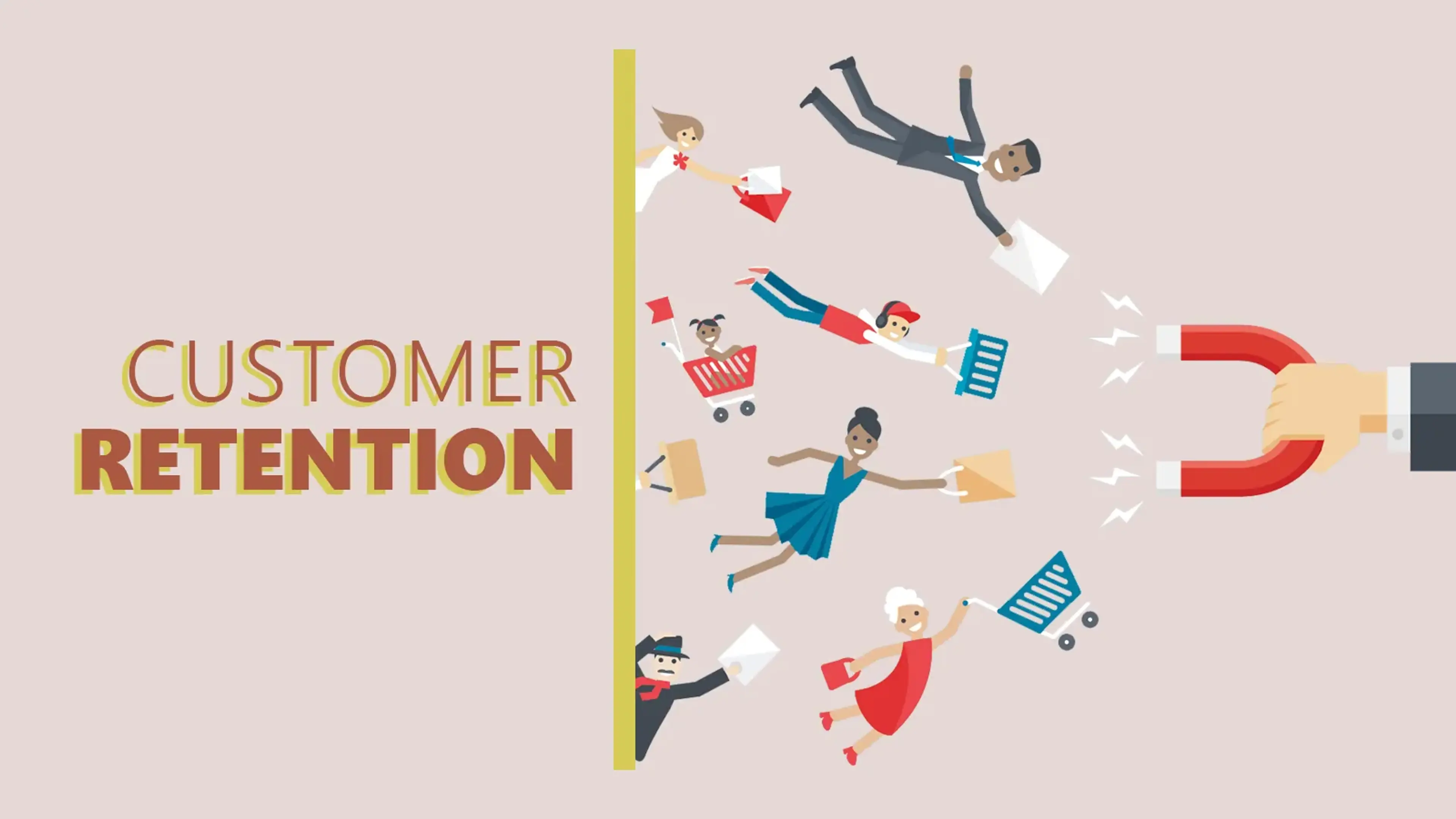


-a7e9a3.png?width=828&q=75&f=webp&auto=format)
